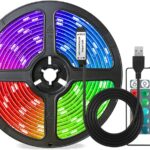Choosing the Ideal Color Temperature for surface mount led to A Comprehensive Guide

Introduction
To choose the right color temperature for your surface mount led (SMD LEDs), you need to have an idea of what ambiance, efficiency and functionality you want for your lighting.
This article will explain the various color temperatures available in the market, their applications and some practical considerations that can help you make a more informed decision.
What is Color Temperature of surface mount led?
Color temperature is measured in Kelvin (K) and it shows what a light source looks like.
It ranges from warm colors to cool colors.
Different temperature colors give different moods and are used in different places.
Types of Color Temperatures
- Warm White (2700K – 3000K)
Characteristics: Warm white LEDs emit a soft, yellowish light similar to traditional incandescent bulbs.
Applications: Ideal for creating a cozy and inviting atmosphere in residential settings, restaurants, and hotels.
- Neutral White (3500K – 4100K)
Characteristics: Neutral white LEDs provide a balanced, neutral light that is neither too warm nor too cool.
Applications: Suitable for general lighting in offices, retail stores, and schools, offering a clean and professional look.
Characteristics: Cool white LEDs produce a bright, bluish light that enhances visibility and contrasts.
Applications: Perfect for task lighting in workshops, hospitals, and commercial spaces where clear visibility is crucial.
Benefits of Various Color Temperatures
- Warm White (2700K – 3000K)
- Comfort and Relaxation: Warm white light creates a calming and comforting environment, making it perfect for living rooms, bedrooms, and dining areas.
- Aesthetic Appeal: It complements traditional and rustic decor styles; thus enhancing the overall warmth as well as charm of such spaces.
- Energy Efficiency: In comparison to conventional incandescent bulbs that consume more power alongside providing adequate illumination level; they are economical on energy saving approaches by generating just enough intensity of illumination necessary with less power usage by warm white LEDs.
- Neutral White (3500K – 4100K)
- Versatility: Neutral white light is versatile, making it suitable for various settings, from offices and classrooms to retail spaces.
- Balanced Illumination: It provides a balanced illumination that reduces eye strain while affinity for clarity and focus.
- Professional Atmosphere: Work environments benefit from this clean and professional atmosphere created by neutral white LEDs in terms of productivity and vigilance.
- Enhanced Visibility: Cool white light offers excellent visibility, making it suitable for task-oriented spaces such as laboratories, workshops, and garages.
- Modern Look: This is the best lighting if you are looking for something modern; especially for contemporary and minimalist designs
- High Contrast: Detail visibility will be great with cool white LEDs since they enhance contrast as well as colors. Thus it has a significant advantage in contexts where precision work is necessary.
How to Choose the Right Color Temperature
- Residential Spaces
Living Rooms and Bedrooms:
Best Choice: Warm White (2700K – 3000K)
Reason: Creates a relaxing and cozy atmosphere, ideal for unwinding and socializing.
Kitchens and Bathrooms:
Best Choice: Neutral White (3500K – 4100K)
Reason: Provides clear, balanced illumination for tasks such as cooking and grooming without being too harsh.
Home Offices and Studios:
Best Choice: Cool White (5000K – 6500K)
Reason: Enhances visibility and focus, making it easier to work on detailed tasks requiring concentration.
- Commercial and Industrial Spaces
Offices and Conference Rooms:
Best Choice: Neutral White (3500K – 4100K)
Reason: Offers a professional environment where employees can concentrate on their duties without straining their eyes.
- Retail Stores & Showrooms:
Best Choice: Neutral White (3500 – 41000k )
Reason: Gives a neutral, flattering light that makes the products look good to the customers.
Workshops and Laboratories:
Best Choice: Cool White (5000K – 6500K)
Reason: Bright high contrast lighting needed for precision work.
- Outdoor Space
Gardens and Landscape Illumination:
Best Choice: Warm White (2700K – 3000K)
Reason: Makes the place more welcoming and nature-friendly by enhancing the beauty of outdoor areas.
Security and Street Lighting:
Best Choice: Cool White (5000K – 6500K)
Reason: Provides clearly lit and brightly illuminated streets, making them safer for motorists.
Practical Considerations When Selecting Color Temperature
- Matching Existing Lighting
When adding a new surface mount led to an existing light network, it is necessary to match the color temperature in order to maintain consistency. Discordantly unbalanced lighting can also be created by mismatched lights.
- Purpose and Functionality
Choose color temperature according to the use of the given area. Warm white is preferred for places requiring relaxation such as bedrooms.
Cool white is better suited for tasks that require precision and clarity like workshops.
- Aesthetic Preferences
Personal preferences and design are significant when choosing color temperature. Some may like the comfortable feel of a warm white while others may opt for cool white because it gives a modern look or appearance which is sharp.
- Energy Efficiency
Specific color temperatures of all LED choices are energy-efficient; however, they may affect energy perception and efficiency. Warmer lights may seem less intense but still offer sufficient brightness, while cooler lights may appear more powerful.
Conclusion
The right color temperature choice for surface mount LEDs means understanding the unique characteristics and applications of warm white, neutral white, and cool white light colors.
You can make a space that improves convenience, productivity as well as visual appeal by aligning color temperature with purpose, aesthetic preference and function.
If you are illuminating an intimate living room, busy office or intricate workshop , your lighting quality and effectiveness can greatly be improved upon by choosing appropriate color temperature. Utilize this adaptability characteristic of surface mount led by picking out a suitable Kelvin rating that goes together with your needs best.











